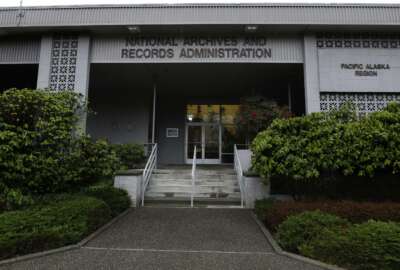NARA targets collaboration platforms, social media for improved records management
Laurence Brewer, the chief records officer for the National Archives and Records Administration, said a new bulletin and a new report demonstrates ongoing chall...
Zoom, Teams, WebEx, whichever platform your agency uses, a record is created. And now new guidance from the National Archives and Records Administration is going to help you manage all those planning meetings, presentations and the like.
Laurence Brewer, the chief records officer for NARA, said this new bulletin and other guidance will support agencies as they manage and maintain records with these now popular platforms and tools.

“It relates directly to a goal that we have in our current strategic plan to issue more guidance around emerging technologies, and collaboration coming out of the pandemic was a key issue as agencies were working together using all kinds of collaboration platforms,” Brewer said in an interview with Federal News Network at the recent 930 Gov conference. “The bulletin is really an attempt to define what a collaboration platform actually is, and describe the kinds of records that are created on collaboration platforms and give agencies a little bit of guidance of what the records management implications are for managing those records that we all as agency employees are creating when we’re collaborating using these tools.”
Brewer said the records agencies are creating are more complex in many ways because of video, chat and other tools on the platforms.
NARA released the collaboration platform bulletin on Sept. 29 answering 10 questions around areas like factors in managing records through these technologies, agency responsibilities when providing these platforms to other agencies and when to capture records through video and chat functions.
“The bulletin and the policies that we issue are really the beginning point of a process for us where outreach is critically important to what we do. We spend a lot of time talking about what we’ve issued at conferences, at our bimonthly bridge meetings where we meet with agencies and at the Federal Records Management Council meetings that we have with departmental records officers. We also take the policies and bake it into the training that we offer for all agency records officers,” Brewer said. “And to the extent that we can, as we incorporate requirements in new regulations, we’re always looking to revise our regulations to make them aligned and consistent with what we’re doing in the bulletins. But it’s really our first step in terms of like getting the word out. We have always looked to expand and increase the mechanisms by which we communicate.”
NARA’s social media assessment
That communication strategy becomes even more important as agencies continue to accelerate and expand how they use social media tools to interact with citizens and businesses.
NARA released an assessment of agency efforts in September that analyzed the policies, practices, procedures and tools at 10 agencies. The idea was to determine how agencies were meeting the goal of the 2013 bulletin on managing social media records and how that process could be improved.
“The goal of the assessment is to really, for NARA, to learn from the agencies about what they’re doing, and then we expect that we will be issuing some follow up guidance that will include some requirements for agencies, which will reflect what we already have in a NARA regulations to sort of extend those guidelines to the specifics of social media management,” Brewer said. “We always want to try and stay ahead of the curve, but it’s difficult when you’re issuing guidance because you need to really learn what’s going on. You don’t want to get too far ahead and you want to make sure that the guidance that you’re issuing is based on real experiences that agencies are having. I think our approach in the past is to try and be, to the greatest extent that we can, technology agnostic, and really focus on the records that are produced and a lot of the tools.”
The goal of the 10-agency assessment for NARA was to learn what some of the barriers are in collecting records from social media tools and then how can those obstacles be overcome.
“Federal agencies should evaluate how it uses social media platforms, define what constitutes their social media records and how those records are preserved and managed, taking into consideration each of the findings and recommendations in this report,” the report stated. “Agencies should also consider dedicating more resources to IT solutions that automate records retention of SM records.”
NARA came away with 12 major findings and 13 recommendations focused on everything from agency documentation and compliance with NARA’s 2013 bulletin to methodologies and procedures for managing their social media platforms, to how they train employees to manage social media records.
Brewer said the report demonstrated most agencies understand what their records management requirements are, but the challenge is, of course, making sure those controls are “baked into the process.”
“That’s what we work with agencies on making sure that they understand. If they pick this tool, they’ve got to make sure those records management controls are in place, particularly if we’re looking at accounts that might have permanent records, their senior officials, we want to make sure that those records are well managed,” he said.
Copyright © 2024 Federal News Network. All rights reserved. This website is not intended for users located within the European Economic Area.
Jason Miller is executive editor of Federal News Network and directs news coverage on the people, policy and programs of the federal government.
Follow @jmillerWFED






